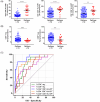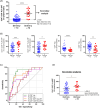Immunophenotyping and Activation Status of Maternal Lymphocytes to Predict Spontaneous Preterm Birth in Women With Threatened Preterm Labor: A Prospective Observational Study
- PMID: 39625044
- PMCID: PMC11613301
- DOI: 10.1111/aji.70015
Immunophenotyping and Activation Status of Maternal Lymphocytes to Predict Spontaneous Preterm Birth in Women With Threatened Preterm Labor: A Prospective Observational Study
Abstract
Problem: Preterm birth (PTB) remains the leading cause of neonatal morbidity and mortality. Identifying women at high risk of spontaneous preterm labor (PTL) is challenging due to limited efficient diagnostic markers. Since human parturition involves inflammatory immune processes, we hypothesized that phenotyping of maternal peripheral lymphocytes might predict PTL. Therefore, we aimed to explore the relationship between maternal lymphocyte subpopulations and labor onset characterized by delivery within 7 days of admission in women hospitalized for PTL between 24 and 34 weeks of gestation.
Methods of study: Lymphocyte subpopulations were obtained from peripheral blood samples and characterized by flow cytometry: activated and regulatory T cells, natural killer and B cells, and TH1/TH2/TH17 lymphocytes. Data analysis was conducted retrospectively based on the delivery within 7 days of admission.
Results: Among 167 women admitted for PTL, less than 10% delivered within 7 days post-admission. HLA-DR expression was significantly increased on CD4+CD8-, CD4-CD8+, and CD4+CD8+ lymphocytes in women who delivered within 7 days. Subset levels below 5% of CD4+CD8-HLA-DR+ lymphocytes and 20% of CD4+CD8+HLA-DR+ lymphocytes were associated with no probability of delivering within 7 days.
Conclusion: Our study suggests that combining these two consecutive markers allowed us to identify 57% of women hospitalized for PTL with no probability of delivering within 7 days while retaining patients who delivered within 7 days. If prospectively validated, these markers may be able to identify patients at high risk of PTB and avoid a significant number of unnecessary admissions and healthcare costs.
Trial registration: ANSM number: 2010-A00516-33; ClinicalTrials.gov identifier: NCT01340222.
Keywords: T cells; biomarker; immunophenotyping; preterm labor; prospective study.
© 2024 The Author(s). American Journal of Reproductive Immunology published by John Wiley & Sons Ltd.
Conflict of interest statement
The authors declare no conflicts of interest.
Figures



References
Publication types
MeSH terms
Substances
Associated data
Grants and funding
LinkOut - more resources
Full Text Sources
Medical
Research Materials

